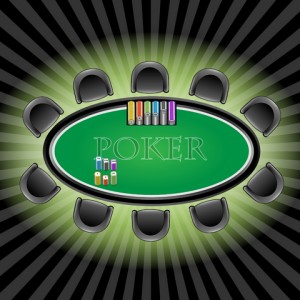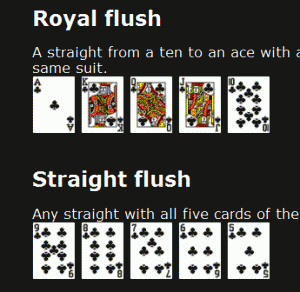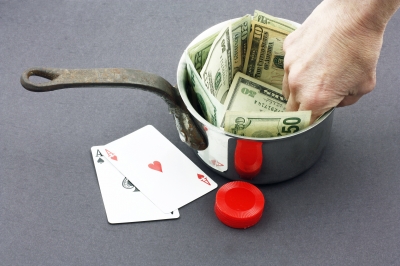Poker is essentially a game of betting and probabilities.
If the chance that you will win is better than the odds you are given on the bet – you should decide to take (or make) the bet.
A deep understanding of odds and probabilities is hugely helpful in becoming a better poker player.

Read this article and use the poker training exercises to practice and you will soon get the hang of it.
As an example imagine someone proposing you a bet were you will win $4 each time a 6 comes up on a dice and lose $1 every time anything between 1 and 5 comes up. Would you take this bet?
This bet is a bad proposition for you, because you are guaranteed to lose money in the long run (how long depends on something called variance, but that’s another topic).
You can see that this is a bad bet by calculating odds and probabilities.
The money odds you are getting on a 6 coming up is 4:1. You win $4 if it comes up and you lose $1 if it does not come up. This is written as 4:1.
The chance that there will be a 6 on each roll of the dice is 1 in 6. This means that it is 5 times as likely that there will a number other than a 6 on each roll. This can be written as 5:1.
To determine if a bet is good or bad you compare the money odds that you are getting with the probability that you will win.
In this example you compare the money odds of 4:1 with the odds that you win which is 5:1. The money odds are smaller in this example which means it is a bad bet. If you were getting $5 for the 6 instead the money odds would be the same as the win odds an the bet would be neutral. In the long run you would neither lose nor win money on such a bet. And if you were offered more the $5 for each 6 it would be a good bet and you should take it.
All casino games (except Black Jack where card counting can be used), lotteries and such are based on giving worse odds to the players than to the bank. And the players will always lose in the long run.
But fortunately poker isn’t played against the bank. And in poker you can use better understanding of odds to give yourself an advantage over your opponents.
Odds
Usually two concepts are used for odds in poker, pot odds and implied odds (negative implied odds are sometimes called reverse implied odds).
Pot odds are the odds you are getting from the money in the pot right now and the money you need to pay to call.
Implied odds take into account money that you can win or loose later in the hand.
Pot odds are calculated and Implied odds are an estimation based on things like probabilities for cards to come, opponent tendencies and such.
Example with Pot Odds
The pot is $12. Opponent bets $6. Your pot odds are calculated by looking at the money you can win ($18) and the money you will put in the pot ($6). The ratio is 3:1. You get this by dividing 18 with 6.
Example with Implied Odds
The pot is $12. Opponent bets $6. You have a fairly disguised open-ended straight draw. Your opponent is aggressive and by considering his tendencies you and likely hand range you estimate that you will win in average $30 more if you hit your draw on the turn (he will often bet and sometimes call a raise).
Your Implied Odds are calculated by dividing the money you expect to win when hitting with the money you are betting (12 + 6 + 30 / 6 = 8:1).
Outs
If you believe your opponent may have a better hand than you, but that some cards will improve your hand to become the best you call each of these cards an “out”.
Example using Outs
You believe you opponent has a top-pair (one of his hole cards make a pair with the highest card on the board) or an overpair (he has a pocket pair as hole cards and it is higher than the highest card on the board) and you have 4 cards in the same suit with your hole cards combined with the board.
In this case all cards that complete your flush draw are likely to give you the best hand. 4 cards are already out in the suit and 9 remains. The 9 remaining cards are called outs.
If you instead have an open-ended straight draw (can be completed upwards or downwards) you have 8 outs (if you believe the straight will give you the best hand).
Other examples:
- 2 overcards – 6 outs
- Gutshot straight draw (need a card in the middle to complete) – 4 outs
- Gutshot straight draw + a flush draw – 12 outs
- Backdoor draw (same for flush and open-ended straight) – 1 out (only relevant on flop looking to river)
There is a simple rule of thumb to estimate how likely it is that your hand will improve with the help of the outs.
It is called the rule of 4 and 2 and gives a good approximation.
With one card to come the probability that you will hit your hand is number of outs * 2
With two cards to come the probability that you will hit your hand is number of outs * 4
Example with Outs
The pot is $12. Opponent bets $6. You have a fairly disguised open-ended straight draw. Your opponent is aggressive and by considering his tendencies you and likely hand range you estimate that you will win in average $30 more if you hit your draw on the turn (he will often bet and sometimes call a raise).
Your Implied Odds are calculated by dividing the money you expect to win when hitting with the money you are betting (12 + 6 + 30 / 6 = 8:1).
Should you call (not considering raising now as this is an example of Implied Odds and Outs)?
You have an open-ended straight draw. This means 8 outs. 8 outs gives you 16 % chance with one card to come. 16 % chance is the same as 5:1 odds. Your Implied Odds are 8:1 and your odds for improving is 5:1. This is a clear call.
Discounted Outs
To complicate things a bit there is something called discounted outs. This is used for situations where you are uncertain if your hand will improve to be the best if these cards hit. For example if you two overcards but you believe that hitting either of them will only improve your hand to be best half of the time (for example if you believe your opponent will have a higher overpair half of the time). Then you compensate for that by changing the probability that you will hit a winning hand. If you estimate that the cards will help you to the best hand 50 % of the time, you have to half the probability. In this case you have 6 outs, but you discount half of them (the discounted outs) so your “real” outs are 3 and you have 6 % probability to get a winning hand on one card, and 12 % with two cards.


























